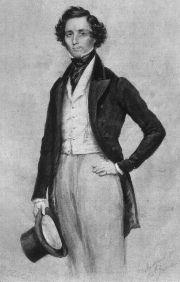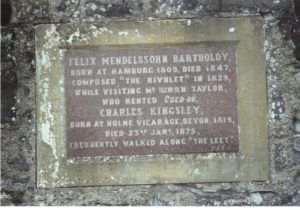By Diane J P Johnson
An account of the visit of the famous German composer, Felix Mendelssohn-Bartoldy, to Coed Du, Rhydymwyn, in 1829.
 Mendelssohn was born in Hamburg in 1809 into an upper-middle class family & from a very early age he showed great musical & artistic talent. By his mid-teens he had established himself as a composer of note as well as showing gifts as a conductor.
Mendelssohn was born in Hamburg in 1809 into an upper-middle class family & from a very early age he showed great musical & artistic talent. By his mid-teens he had established himself as a composer of note as well as showing gifts as a conductor.
As was customary for wealthy young men of that period, Mendelssohn began a period of European travel to perform & promote his music in 1829 & over the next few years he visited England, Scotland, Wales & Italy. It was during this time that the ideas of his famous Italian & Scottish Symphonies were born.
After his tour of the Hebrides in Scotland, he travelled to Wales with the intention of visiting Ireland. He never achieved this as the weather was so bad & with the prospect of a very nasty crossing, he retraced his steps. At some point on this journey he arrived at Llangollen but was not impressed by the Welsh or their music as can be deduced from this letter he wrote from his inn –
‘Ten thousand devils take all national music! Here I am in Wales, and, heaven help us! a harper sits in the hall of every reputable tavern incessantly playing the so-called folk melodies – that is to say, dreadful, vulgar, out-of-tune trash with a hurdy-gurdy going at the same time! It has given me toothache already.’
However his attitude did mellow after his discovery of a piano in the inn & that the innkeeper’s pretty daughters played it, so that after an evening of music making with them he began to be more sympathetic towards the Welsh!
The next part of his journey took him to Coed Du, just outside Rhydymwyn where he spent a week with the Taylor family. John Taylor was a mining engineer working in the local lead mines who rented this large house.
He had been introduced to the Taylors in London through the agency of their aunt, Mrs Austin, who had known his cousin, Professor Mendelssohn at Bonn, Germany. They had met at their London home in Bedford Square & the glimpse he had of the Taylor daughters – Susan, Honoria and Anne –had made him only too eager to accept an invitation to Coed Du.
Again making use of Mendelssohn’s own words through a letters written at the time, we can garner an impression of life at Coed Du during his visit: –
September 2nd, 1829
‘Here I am in Coed Du, the country house in Wales….. from Llangollen I drove to Holywell ….. had a bad room, had a smoky chimney and found my Inn comfortless and dreary. Then Coed Du. I wish I had the gift of description. Mr Taylor is the most English Englishman you can imagine. He has six lead mines which he manages with his sons. They go fishing, train their dogs and make fun with their sisters … All three look very nice. The mother is very placid and good; one feels that she is the ruling spirit although she talks little ….. The scene is between Mold and Ruthin, Flintshire. In every respect I live splendidly here … There is much music …. I have promised to set to music the nosegay of carnations for Miss Anne. Implicite my music is when we all sit together by the sluice.’
From another letter we appreciate the whole story of the famous compositions: –
My stay at the Taylors was one of those times of which I shall never lose the flowery memory, and I shall always recollect the meadows and woods, the brook with its pebbles and rustling sound … I am truly fond of these girls … I owe them three of my best piano compositions. …. For the two younger sisters I took the carnations and roses and began to write music. And for the other sister I composed the ‘Rivulet’ which has pleased us so much during our ride that we dismounted and sat down by it ….. I believe it is the best I have done in that way; it is so flowing and quiet, and drowsily simple, that I have played it over to myself every day, and have got quite sentimental over it. I drove away in the evening. The lights in the house sparkled through the bushes in the distance. I passed by several favourite places, the gentle brook already mentioned, the last hedge of property, and then off I went at furious English speed.’
There is other evidence of happy family life enjoyed here – with picnics, descents into lead mines & a tour to Caernarfon & Snowdonia. There is an extant pencil drawing Mendelssohn made of Telford’s Suspension Bridge at Conwy on 26 August 1829.
Many years later, Anne wrote recalling his visit & her gradual discovery that she had and her sisters had been entertaining a musical genius unawares. She describes him as having a slight lisp & that when nodding his head in approval of something his long dark hair flopped down over his forehead.
After leaving Coed Du he intended travelling back to the Continent to attend his sister’s wedding on October 3rd in Berlin, however he had a carriage accident & was badly injured. He had to remain in London for several weeks where he was thoroughly spoiled but it did mean he never managed to get to the wedding!
That is the end of the description of this important visit made by one of the greatest composers of the 19th century to this lovely unspoiled area of North Wales & to its immortality through his music.
I must thank Alan Spedding who inspired me to write this article with the story that whilst being an evacuee during the war at Gwernaffield he often played these pieces that had been composed only a short distance away.
The Reverend J. Burford Parry
Some of the letters quoted here are from an article published in ‘The Leader’, January 29, 1954, from a Rev. J. Burford Parry of Massachusetts in reply to a query in the paper regarding Mendelssohn’s visit to Rhydymwyn. This
gentleman had in his possession a rare volume of letters written by the composer to his family in Germany describing his impressions. These letters had been published in 1882, many years after his death in 1847.
Mr Burford Parry had been born in Mold, his parents having lived at Bro Alyn, Lead Mills.
To quote from the newspaper …. ‘He began life as a printer at Bellamy’s, High Street, Mold, and attended the Congregational Church, where the minister, the Reverand Burford Hook, was responsible for the young printer being given the opportunity to study for the Ministry at Oxford. The Rev. Burford Parry has relatives still in Mold, one of whom is Mrs Hilditch, of Hendy Farm.’
At the end of this Leader article is an interesting note, stating that ‘It might be further of interest to know that these volumes will ultimately find their home in the Public Library in Earl Road, Mold.’
‘Mold has already cause to be grateful to Mr Parry, for he founded the Maude Parry Memorial, in memory of his late wife. Under the terms of this memorial, crates of valuable American books, arrive periodically at Mold Library, donated by him.
(I am sure that these two last pieces of information will be worthy of further investigation in the future. D.J.)
Photo Courtesy of Bill Jones
Copyright of articles
published in Ystrad Alun lies with the Mold Civic Society and individual contributors.
Contents and opinions expressed therein
remains the responsibility of individual authors.
